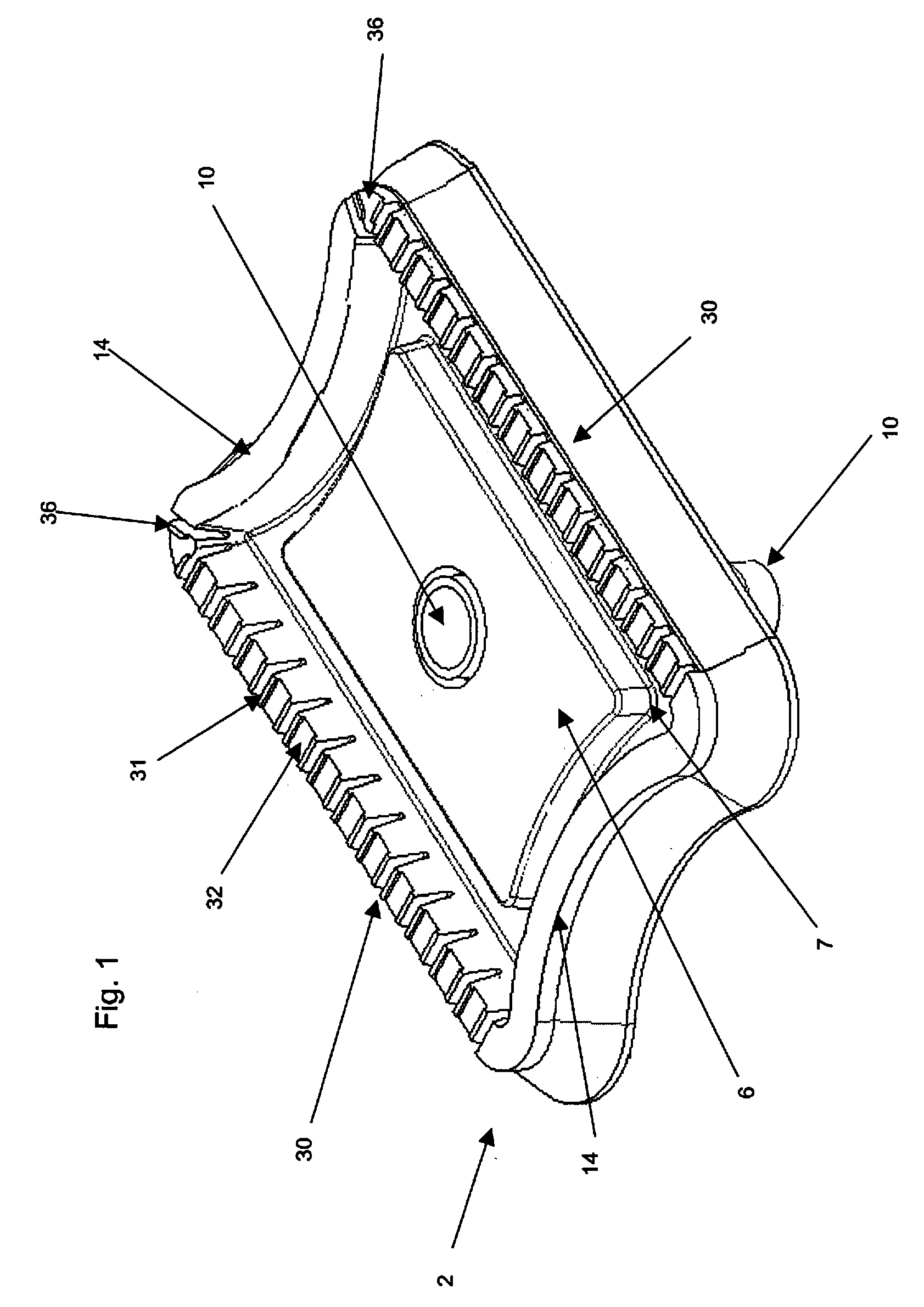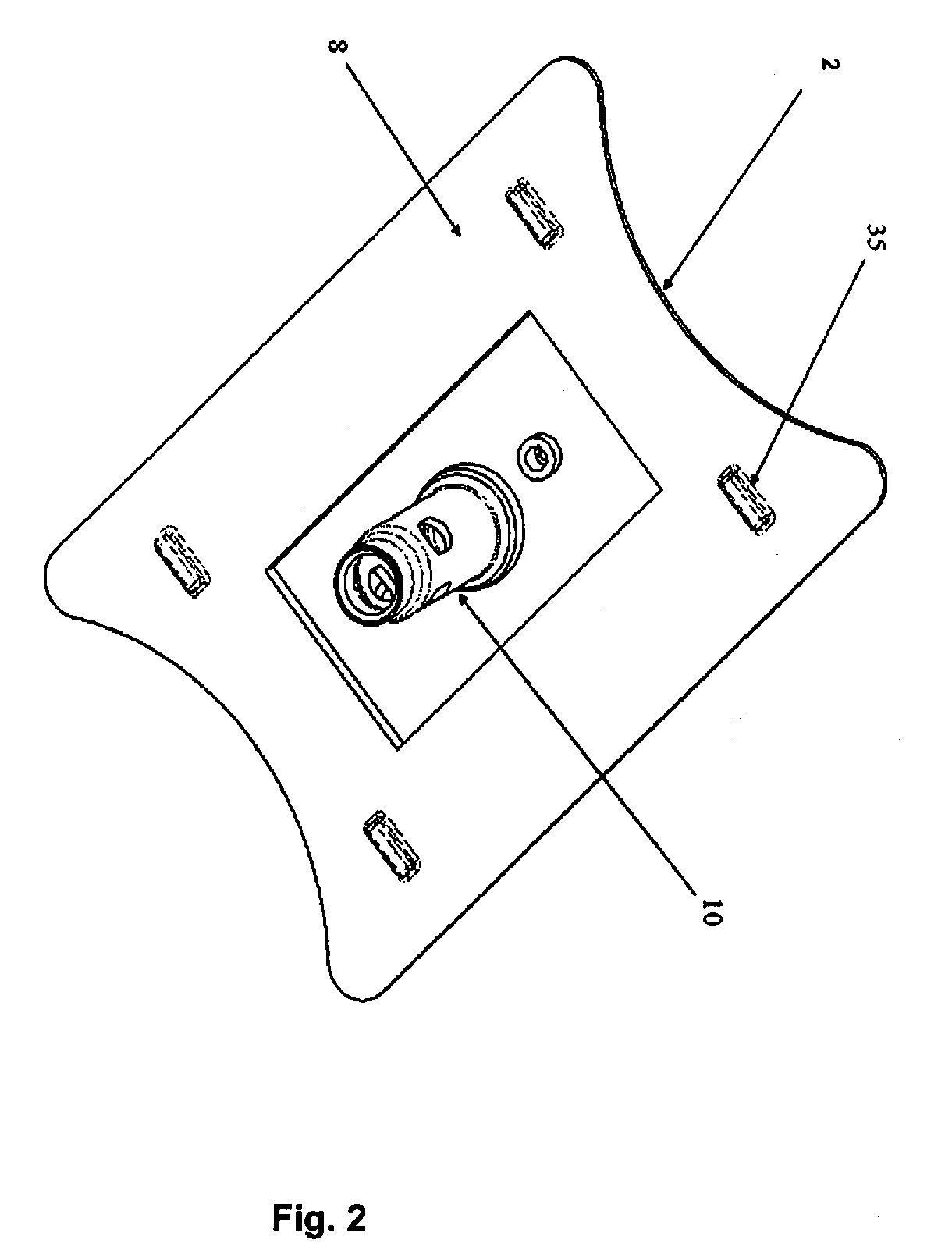Double flame perimeter burner
a burner and perimeter technology, applied in the direction of combustion ignition, heating fuel, combustion process, etc., can solve the problems of no burner, insufficient thermal capacity of fixed predetermined areas for cooking,
- Summary
- Abstract
- Description
- Claims
- Application Information
AI Technical Summary
Benefits of technology
Problems solved by technology
Method used
Image
Examples
first embodiment
of the Invention
[0049]FIG. 1 shows an isometric superior view of the satellite burner 2 of the present invention, said burner has a semi-rectangular form, showing in its longer sides port zone 30 longitudes. In its perpendicular sides, the satellite burner 2 has a neck 14 or an arc segment, to cooperate in its ends with the main burners 1, which preferably have a round geometry.
[0050]As appreciated in FIG. 3a, a mixer or Venturi tube 10 allowing the fuel gas mix, coming from flow regulating valves 15, to be directed to a nozzle 16, which reduces the pressure and allows a determined flow velocity. The mixer tube 10 embraces the nozzle 16 by means of a throat 19, which may be above said nozzle 16, so that the flow coming from the nozzle 16 may be introduced to the mixer tube 10, generating a Venturi effect dragging the air around, introduced by the windows 18. The mixer tube 10 has a regulating ring (not shown), which restricts the air pass to the interior of the mixer tube 10, to mod...
second embodiment
of the Invention
[0066]FIG. 8 shows a second embodiment of the burner of the present invention. Main burner 1 has modified its form to a kind of horse-shoe. Over the periphery of this horse-shoe the port zone 30 is found. Once moved the circular form of the main burner 1 to this new horse-shoe form, we shall call this burner to distinguish it as horse-shoe main burner 5. When fusing the horse-shoe main burner 5 with the secondary burner 2, a body 37 is obtained, with semi-rectangular form in the front of two burners 5, 2 and with the lateral ends in semicircular form.
[0067]The horse-shoe main burner 5 and the satellite burner 2, are fused in the same body 37, having an advantage when both burners 5, 2 are assembled, produced, maintained and installed.
[0068]In a descriptive however not limitative manner, a port design as was disclosed for the before embodiment may be considered. As shown in FIG. 8, the arc segment 14 of the satellite burner 2 does not have ports, thus no flame is emit...
third embodiment
of the Invention
[0072]With the fusion of both burners in a single body 37, a main burner 1 and a satellite burner are joined again in a single body, providing the advantages of: manufacture, assembly, maintenance and less part numbers to handle.
[0073]The main burner 1 and the satellite or secondary burner 2, are cinched in a single base 38, wherein the fused main burner 1 will be called circumcised main burner 21. As seen in FIGS. 11 and 11a, said circumcised main burner 21 retains its port zone 30, spark 20, plateau 6, chamber 7 and cap 11, with the peculiarity of being joined to the satellite burner by means of a base 38, allowing having both burners 21 and 2 contained in a single piece. Therefore, the secondary burner 2 also retains its port zone 30, plateau 6, chamber 7, cap 12 and a pair of flame transfer ports 36 in its ends of the port zone 30 closest to the circumcised main burner 21, such as was disclosed for the first embodiment of the invention. Said description is here a...
PUM
 Login to View More
Login to View More Abstract
Description
Claims
Application Information
 Login to View More
Login to View More - R&D
- Intellectual Property
- Life Sciences
- Materials
- Tech Scout
- Unparalleled Data Quality
- Higher Quality Content
- 60% Fewer Hallucinations
Browse by: Latest US Patents, China's latest patents, Technical Efficacy Thesaurus, Application Domain, Technology Topic, Popular Technical Reports.
© 2025 PatSnap. All rights reserved.Legal|Privacy policy|Modern Slavery Act Transparency Statement|Sitemap|About US| Contact US: help@patsnap.com



